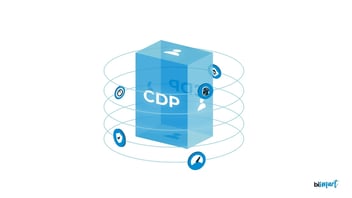Learn how to implement a Customer 360° strategy to enhance customer relationships. Discover the benefits and success stories to a 360 Customer View.
In the digital age, data has become one of the most valuable assets for companies. The ability to collect, analyze and use this data can make the difference between success and failure.
One of the most effective strategies for maximizing the value of data is the implementation of a 360 customer view. This strategy does not only provide a holistic view of each customer, but also allows you to personalize experiences, optimize marketing campaigns and improve decision making in real time.
What is a 360 Customer View?
A 360 customer view is a comprehensive approach that seeks to consolidate all relevant customer information from multiple sources. This includes demographic data, purchase history, social media interactions, website behavior, and more.
The goal is to create a detailed and unified profile of each customer, giving companies a holistic view that allows them to better understand their needs and behaviors.
Case Study: 360° Customer View
Discover how a leading pharmaceutical company managed to leverage customer data by implementing a personalized 360 Customer Platform. This success story reveals innovative tactics and amazing results such as:
- 25% increase in email campaign open rate
- 35% increase in engagement
- Optimization of customer satisfaction by 20%
- Improved conversion rate by 15%.
Case Study: Customer 360
Discover how a pharmaceutical company managed to improve its relationship with its customers.
The value of 360 customer data for creating a 360° customer view
A major aspect of the effective implementation of a 360 customer strategy is the creation of a single customer view. This repository centralizes all customer information, integrating it from multiple sources and eliminating data fragmentation. This allows companies to have a unified and consistent view of each customer, which is critical to developing personalized and effective strategies.
Single customer views also facilitate the creation of complete customer profiles, integrating data from different departments that would otherwise be stored in data silos. This does not only improve operational efficiency, but also enables better collaboration and a more cohesive approach to customer experience management. In addition, by having unified data, companies can easily identify what information is missing and take action to collect the necessary data, further enriching customer profiles.
What is the purpose of creating a 360° customer view?
Creating a 360º customer view has multiple benefits and applications:
- Personalization of offers and services: It allows tailoring offers and services to the individual preferences of each customer, improving their satisfaction and loyalty.
- Optimization of marketing campaigns: Facilitates the creation of more effective campaigns by better understanding market segments and their specific needs.
- Improved customer experience: Provides a more consistent and seamless experience across all customer touch points, from the first interaction to after-sales service.
- Predictive analytics: Uses historical data to predict future behavior and trends, which can guide strategic and operational decisions.
What is the importance of 360 customer strategies?
Implementing a 360 customer strategy is crucial for several reasons:
- Data-driven decisions: It provides detailed and comprehensive information that enables companies to make more informed and effective decisions.
- Increased operational efficiency: Having a single, centralized view of customers reduces duplication of effort and improves cross-departmental collaboration.
- Trend and pattern detection: Allows you to identify business opportunities and gain competitive advantages by analyzing large data sets.
360 Customer Examples: Companies using a 360° Customer View
Amazon
Amazon is a clear example of a company that has successfully implemented a 360 customer view. The company uses shopping and browsing behavior data to recommend relevant products to its customers, enhancing cross-selling and up-selling strategies. Its "frequently shopped together" feature is a demonstration of how a holistic view of the customer can significantly increase sales and customer satisfaction.
Netflix
Netflix uses predictive analytics to suggest personalized content based on its users' viewing history. This strategy not only improves the user experience, but also increases the time customers spend on the platform, boosting their retention. In fact, it is estimated that 80% of the content watched on Netflix comes from its automatic recommendations.
Sephora
Sephora uses a 360 customer view to track its customers' product preferences and purchase history. This allows them to offer personalized recommendations and rewards, which increases customer loyalty and encourages more frequent purchases.
How to implement a 360° view of the customer?
Implementing a 360 customer view involves several core steps:
- System integration: It is critical to unify dispersed systems and databases to centralize customer information. This includes integrating data from sales, marketing, customer service and other key areas.
- Adoption of advanced CRM platforms: Use robust and customizable platforms such as Salesforce, HubSpot and Microsoft Dynamics 365 to effectively manage and analyze customer data.
- Use of analytics and artificial intelligence: Implement data analytics tools and AI techniques to gain valuable real-time insights about customers. These tools enable the identification of patterns and trends that can guide strategic decision making.
- Focus on privacy and security: When handling large amounts of sensitive customer information, it is crucial to ensure data security and protection to comply with regulations and build customer trust.
Customer 360 in the pharmaceutical industry
The implementation of Customer 360 views in the pharmaceutical industry presents unique challenges and particularities, especially due to the diversity of its customers, which include not only end consumers but also medical professionals, hospitals and pharmacies.
This introduces additional challenges in data management and personalization of the customer experience (CX), due to strict regulations on the management and protection of personal and professional data.
Recent investigations project that in less than two years, 85% of pharmaceutical companies will be data-driven. This puts us in a scenario where pharma that does not adopt a comprehensive data and analytics strategy will face a significant competitive disadvantage.
Implementing Customer 360 strategies in the pharmaceutical industry offers numerous benefits:
- Complete Vision of the Client: Enables a complete and personalized understanding of patients and healthcare professionals.
- Customer Experience Optimization: Improves satisfaction and loyalty through detailed insights.
- Regulatory Compliance: Ensures compliance with strict privacy and security regulations.
- Improved Decision Making: Facilitates data-driven strategic decisions.
- Effective Marketing Strategies: Increases effectiveness and personalization of campaigns.
- Promotion of Innovation: Promotes a culture of continuous innovation within the company.
Case Study: Implementation of a 360° Customer Platform in a pharmaceutical company
Would you like to know how a leading pharmaceutical company managed to increase customer engagement by 35%: 20% improvement in customer satisfaction 20% with a tailor-made Customer 360 platform?
Download the case study here:
Case Study: Customer 360
Discover how a pharmaceutical company managed to improve its relationship with its customers.
Customer Data Platform (CDP): Transforming 360 Customer Strtegies
A Customer Data Platform (CDP) is an essential tool for achieving a centralized and unified view of the customer. CDPs integrate data from multiple sources, both online and offline, creating a complete and up-to-date profile of each customer.
In addition, CDPs enable advanced segmentation and the creation of specific audiences, facilitating the personalization and optimization of interactions across all touch points.
Capabilities of a CDP
- Data and system integration: Collects and integrates data from multiple sources in real time, standardizing and modeling data for operational use.
- Creation of unique identities: Creates unique identifiers for each customer, avoiding data duplication and ensuring a consistent view.
- Segmentation and audience creation: Allows to organize and operate with data at both individual profile and customer segment level.
- Assignment of attributes and business rules: Allows the definition of the next best action for each customer based on their data and behavior.
- Customer journey activation: Integrates all touch points and manages the customer lifecycle in real-time.
Areas of impact of a CDP
- More direct relationships: Improves interaction with customers by providing detailed and updated information.
- Audience monetization: Enables the creation of valuable audiences that can be used for commercial agreements and advertising.
- Development of new digital products: Facilitates the discovery of customer preferences, driving innovation and the development of new products and services.
Conclusions
The creation of a 360 Customer View is a powerful strategy that enables companies to gain a holistic view of their customers. This view does not only facilitate the personalization of experiences and the optimization of marketing campaigns, but also improves data-driven decision making and increases operational efficiency.
Leading companies such as Amazon, Netflix and Sephora have demonstrated the benefits of this strategy, and its implementation can be equally transformative in other industries, including pharmaceuticals. Adopting a 360 customer view does not only drive business growth, but also strengthens customer relationships, clearing the way for a more successful and sustainable future.
In short, a 360 customer view represents a paradigm shift in how companies interact with their customers. By integrating and analyzing data from multiple sources, companies can deliver more personalized experiences, spot new business opportunities and stay competitive in an increasingly customer-centric marketplace.
Case Study: Customer 360
Discover how a pharmaceutical company managed to improve its relationship with its customers.



